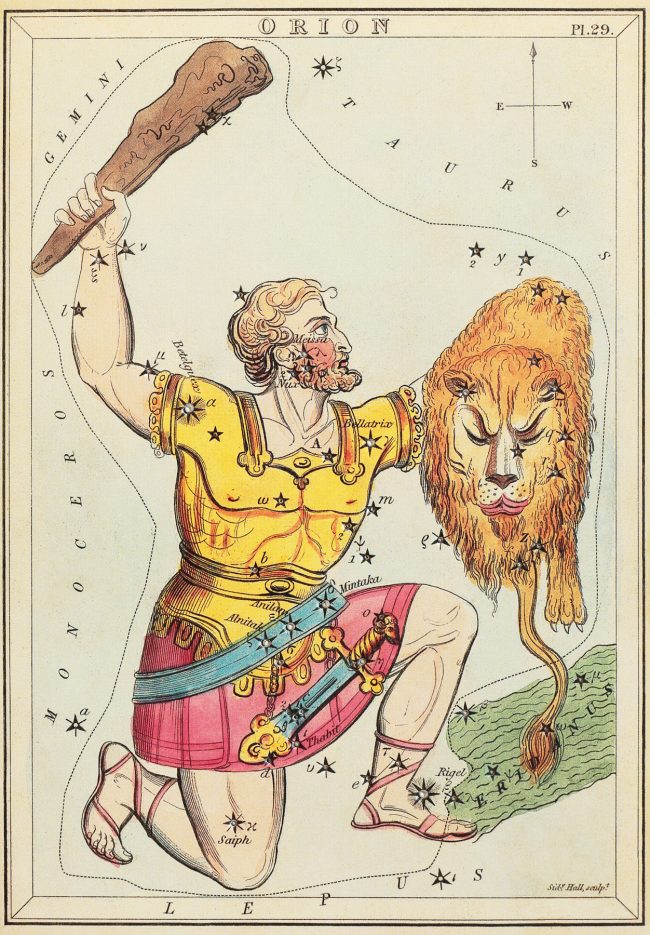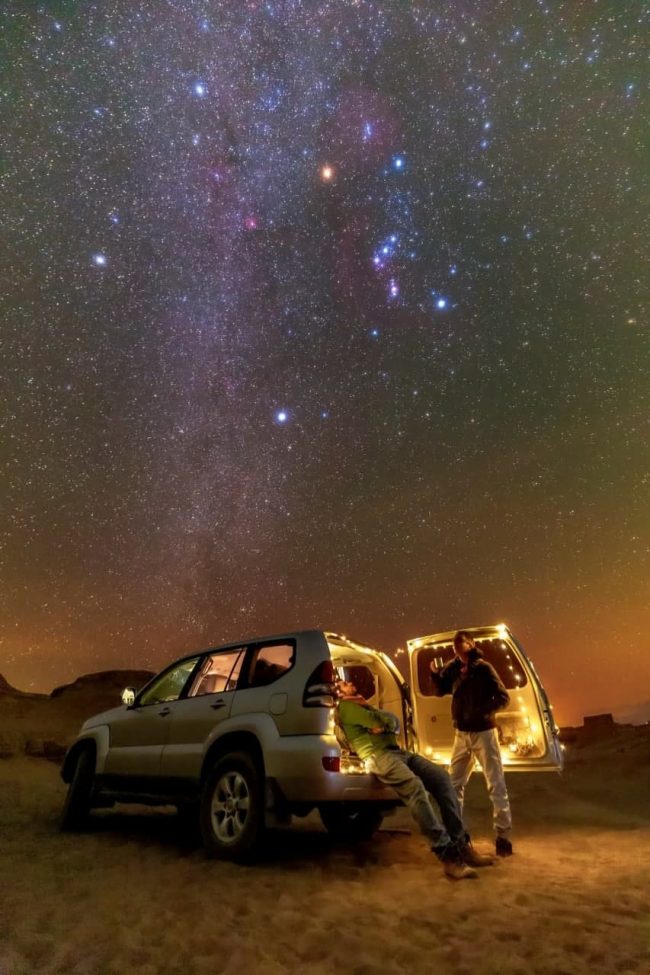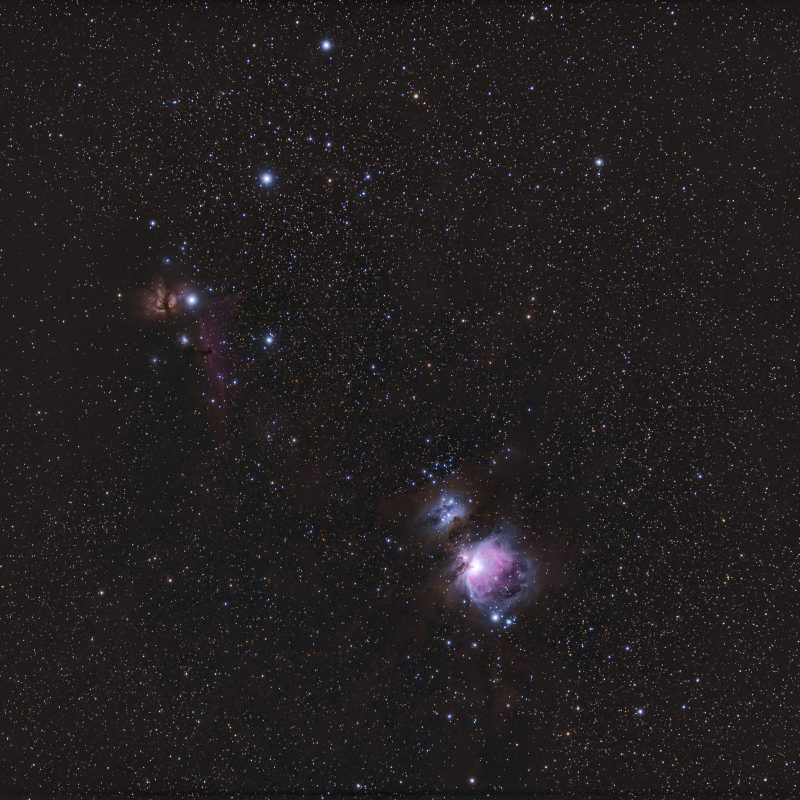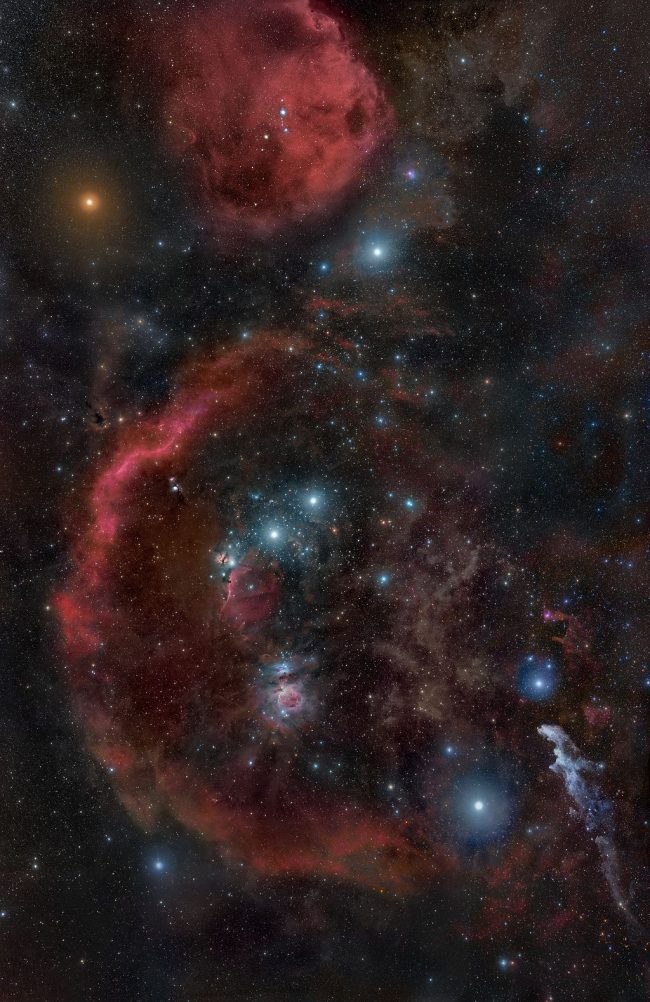
Orion the Hunter is arguably the most recognizable constellation in the world. Orion lies on the celestial equator, making it visible from both the Northern and Southern Hemispheres. Orion’s shape is easy to pick out because of its many bright stars and signature Belt: three stars close together in a nearly straight line.
Mythology of Orion the Hunter
In many drawings of the constellation Orion, the Hunter looks to be battling his neighbor, Taurus the Bull. Yet there is no such story in the mythology of Orion. Some stories have Orion pursuing the seven sisters of the Pleiades, which is a star cluster in the constellation Taurus. On the other side of Orion are his hunting dogs, Canis Major and Canis Minor. (Not to be confused with Canes Venatici, a different constellation with the actual nickname of the Hunting Dogs.)
Mythology says that a scorpion killed Orion; that’s why Orion is on one side of the sky while Scorpius the Scorpion is on the opposite side. As Scorpius is about to rise in the east, Orion makes a hurried exit from the sky in the west.

Brightest stars in Orion
The brightest star in Orion is the bluish Rigel, which marks his western knee or foot. Rigel is a blue supergiant 770 light-years away with a magnitude of 0.2. Rigel is the seventh brightest star in the entire sky. The star marking the other knee or foot of Orion is Saiph, a magnitude 2.1 star. It’s a blue supergiant and 720 light-years distant.
The second brightest star in Orion is reddish-orange Betelgeuse, which marks one shoulder. Betelgeuse is the 10th brightest star in the sky at magnitude 0.5. It’s a red supergiant 430 light-years away and a whopping 800 times larger than our sun. If we substituted Betelgeuse for our sun, it would swallow up all the inner planets.
The third brightest star of Orion, which marks his other shoulder, is Bellatrix. Bellatrix, a blue supergiant shining at magnitude 1.6, is the 22nd brightest star in the sky and 245 light-years away.

Other stars in Orion
Extending out from Bellatrix is Orion’s arm, where he is holding either a shield or an animal, depending on the artist’s concept. The brighter stars marking this object are all of 3rd and 4th magnitude.
Extending upward from Betelgeuse is Orion’s other arm, which holds a club or sword. The brightest stars in the arm and club are all 4th magnitude.
The stars that make up Orion’s head are a test of your sky’s darkness. They range from 3rd magnitude to 6th magnitude. The more stars you can see, the better your skies are.
The three Belt stars from east to west are Alnitak (magnitude 1.8), Alnilam (magnitude 1.7) and Mintaka (magnitude 2.2).

Nebulae of Orion the Hunter
The stars in the Sword that hangs down from the Belt are part of the Orion Nebula (M42). You can see the nebula, or cloud of gas, without optical aid as a hazy, 4th-magnitude patch. Using magnification reveals a quadruple star at the center of the nebula. These four newborn stars – the Trapezium Cluster – light up their dusty cocoon, making its glow visible to us here on Earth, a vast 1,400 light-years away.
The famous Horsehead Nebula lies near the Belt star Alnitak. This dark nebula is a faint target even for most amateur telescopes; your best bet is to view it in a picture compliments of an astrophotographer. (Learn more about dark nebulae.)
Along Orion’s side between Alnitak and Betelgeuse (but closer to the belt stars) is the 8th-magnitude nebula M78. M78 has the awkward title of “brightest diffuse reflection nebula in the sky.” One more notable nebula in Orion is near Rigel and crosses into Eridanus the River. IC 2118, the Witch Head Nebula, is extremely faint but also extremely large, spanning six full moons.

Bottom line: Orion the Hunter may be the most recognizable constellation in the world. It’s visible from the north in winter and from the south in summer.
Read more: Orion the Hunter is easy to spot
The post Orion the Hunter, the world’s most recognizable constellation first appeared on EarthSky.
0 Commentaires